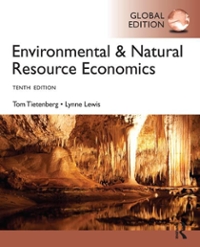Please list and answer the following questions and submit in the assignment folder: 1) Explain the following paragraph in your own words. "A nation which has can produce at a lower cost when measured in terms of opportunity cost is said to have a comparative advantage. Even though the U. S. has an absolute advantage in needing fewer workers to produce a given quantity of either shoes or refrigerators. Mexico has a comparative advantage in the production of shoes and the U. S. has a comparative advantage in the production of refrigerators. Comparative advantage identifies the area where a producer's absolute advantage is relatively greatest, or where the producer's absolute disadvantage in productivity is relatively least. The U.S. can produce 1,000 shoes with four- fifths as many workers as Mexico ( 4 vs. 5), but can produce 1,000 refrigerators with only one-quarter as many workers (1 vs. 4). Thus, the comparative advantage of the U. S., where its absolute productivity advantage is relatively greatest, lies with refrigerators, and Mexico's comparative advantage, where its absolute productivity disadvantage is least, is in the production of shoes." 2) Using the following exhibit from the textbook, explain how the U.S. can gain in trade even though it has an absolute advantage in both shoes and refrigerators. (Your answer should include whether more product is available via specialization.) Exhibit 3-7 Comparative Advantage with Production Possibility Frontiers The tables show several points along the production possibilities frontiers for each country, based on the numbers for what workers produce in Exhibit 3-6 and assuming 40 workers for each country. In the absence of trade, each country would most prefer point A, given its production possibilities. While a point like B provides more of both goods, in a world without trade, a choice like B is impossible. Through specialization and trade, a point like B becomes possible for both countries, showing that both countries can benefit from trade. 12.000 How many workers Output of Output of producing each good? shoes Refrigerators 10.000 40 to shoes, O to 10,000 pairs O refrigerators 3,000 refrigerators 30 to shoes, 10 to 7,500 pairs 10,000 Shoes 6,000 refrigerators refrigerators 20 to shoes, 20 to 5,000 pairs 20,000 4,000 refrigerators refrigerators 2.000 10 to shoes, 30 to 2,500 pairs 30,000 refrigerators refrigerators 0 to shoes, 40 to O pairs 40.000 20,000 40,000 refrigerators refrigerators Refrigerators (a) U.S. PPF (40 workers) 12,000 How many workers Output of Output of producing each good? shoes Refrigerators 10,000 40 to shoes, O to 8,000 pairs 0 refrigerators 8,000 refrigerators 30 lo shoes, 10 to 6,090 pairs 2.500 shoes 6,000 refrigerators refrigerators 20 to shoes, 20 to 4,000 pairs 5,000 4,000 refrigerators refrigerators 2.000 10 to shoes, 30 to 2,000 pairs 7,500 refrigerators refrigerators 0 to shoes, 40 to O pairs 10,000 0 10,000 30,000 50,000 refrigerators refrigerators Refrigerators (b) Mexico PPF (40 workers) 3) If two countries are fairly similar and have workers of the same general productivity levels, explain if there can be any economic gains from trade for them? Why or why not







